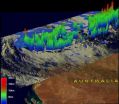(Press-News.org) CORVALLIS, Ore. – Hundreds of lives are being lost each year in the United States because of mistakes made in what engineers call the "dilemma zone" – that area before a stoplight intersection where the traffic light turns yellow and the driver isn't sure whether to stop or go ahead.
New research at Oregon State University will help to more precisely identify that danger zone. Traffic engineers can then use than information, along with advanced technology that can monitor the speed and location of oncoming traffic, to improve yellow-light timing and help address this problem.
When more widely implemented, this approach should help reduce driver confusion, add certainty to how intersections should be managed, and save lives.
"There are more than 30,000 traffic fatalities each year in the U.S., and about 2,000 of them occur in stoplight intersections," said David Hurwitz, an OSU assistant professor of transportation engineering. "We think those crashes can be reduced with a better understanding of exactly where the dilemma zone is and how traffic lights and other technology can be adjusted to help manage it."
Factors that lead to the problems in the dilemma zone include driving speed, distance to the stop light, driver skills, laws that vary by state, occasional scofflaws who are trying to "beat the red light," and simple confusion by drivers who want to do the right thing but aren't sure what it is.
There are many variables involved, Hurwitz said, such as vehicle speed and position. To help address that, researchers in one recent study used a tool called "fuzzy logic." This provides a way to produce more exact decisions with inexact data, which in this case can include everything from drivers with very different skill sets and reaction times to automobile speeds and road variability.
Based on their speed and proximity to an intersection, when the traffic light turns yellow a driver has to make a decision whether to stop or proceed. A driver who is some distance away usually stops; and a driver who is extremely close to the intersection usually will go ahead. Those decisions are fairly easy. But the "dilemma zone" is the area where the choice isn't so obvious, and the wrong decision can have serious, sometimes fatal consequences.
Complicating that, Hurwitz said, is that laws vary widely by state. In Oregon, for instance, the law requires that a car stop on a yellow light if it is safe to do so. In some other states, it's legal to proceed on a yellow light, and even be in the intersection during a red light, if the front axle of the vehicle crosses the stop line before the light turns red.
Different laws can contribute to different driver behaviors, and national standards do not now exist.
Stop too suddenly, and you're apt to have a rear-end collision with the vehicle behind you. Proceed or turn left when you shouldn't, and even more serious crashes can occur, including head-on and side impacts. And based on the speed limit, the length of a yellow light at an intersection can vary greatly.
"In traffic engineering, consistency and uniformity is a critical concern," Hurwitz said. "We want conscientious drivers to know what is the right thing to do. Given so many variables and differences in state law, that can be difficult."
The findings have been published in two recent studies, in research that was supported by the Vermont Agency of Transportation and the Lilo and Richard Smith Transportation Fellowship.
"We want to help drivers know whether to stop or proceed, and do it in a manner that is safe," Hurwitz said. "This approach should help accomplish that, prevent accidents and save lives."
###Editor's Note: A digital image to illustrate this story is available online: http://bit.ly/xqTGGp
The study this story is based on is available online: http://bit.ly/A2THta
The 'twilight zone' of traffic costs lives at stoplight intersections
2012-03-15
ELSE PRESS RELEASES FROM THIS DATE:
An integrated pest management program for coffee berry borer in Colombia
2012-03-15
The coffee berry borer, Hypothenemus hampei (Ferrari), is considered one of the most serious pests in coffee plantations worldwide. Infestations of this small beetle are difficult to combat; most of the insect's lifecycle is completed inside coffee berries, making insecticide penetration and contact difficult. Female beetles bore holes into developing berries attached to the tree through the blossom scar and create 'galleries' where they remain and deposit their eggs. The developing larvae feed on the bean or endosperm of the seed, reducing yields as well as the quality ...
2 new NASA LRO videos: See moon's evolution, take a tour
2012-03-15
In honor of 1,000 days in orbit, the NASA Lunar Reconnaissance Orbiter (LRO) team at NASA Goddard Space Flight Center in Greenbelt Md. has released two new videos.
One video takes viewers through the moon's evolutionary history, and reveals how it came to appear the way it does today. Another video gives viewers a guided tour of prominent locations on the moon's surface, compiled by the spacecraft's observations of the moon.
"Evolution of the Moon" explains why the moon did not always look like it does now. The moon likely started as a giant ball of magma formed from ...
Cloud49 Unveils Software for Human Capital Management
2012-03-15
Fireweed Human Capital Management System (HCMS), a cloud-based application designed to assist businesses with human capital challenges, is now available to companies of all sizes, according to Cloud49, the company that developed the software.
The Fireweed suite is used to track, manage, and report on multiple human resource- related functions within companies and organizations. It comprises five applications: Compliance and Policy Management; Shareholder Management; Student and Scholarship Management; Board of Directors Management; and Compensation Management.
Each ...
End of Winter: How 2012 snow stacks up
2012-03-15
The mild winter of 2012 has many people asking, "Where's the snow?" These two snow cover maps show the difference between snow extent on March 3, 2011, and March 5, 2012. The maps were compiled from data collected by the Moderate Resolution Imaging Spectroradiometer (MODIS) instrument aboard NASA's Terra satellite.
In 2012, the snow cover is very spotty compared to 2011. In 2011, the Great Lakes were clearly defined by surrounding snow, and snow blanketed the Rocky Mountains, Nevada's Basin and Range, and the Sierra Nevada all the way into southern California.
In 2012, ...
How to best help your child lose weight: Lose weight yourself
2012-03-15
A study by researchers at the University of California, San Diego School of Medicine and The University of Minnesota indicates that a parent's weight change is a key contributor to the success of a child's weight loss in family-based treatment of childhood obesity. The results were published today in the advanced online edition of the journal Obesity.
"We looked at things such as parenting skills and styles, or changing the home food environment, and how they impacted a child's weight," said Kerri N. Boutelle, PhD, associate professor of pediatrics and psychiatry at ...
NASA's TRMM satellite sees tropical storm Lua's rainfall
2012-03-15
A tropical storm called Lua formed in the Indian Ocean off Australia's northwestern coast on March 13, 2012. NASA's TRMM satellite passed over Lua and observed moderate rainfall and strong towering thunderstorms within on March 13. By March 14, it was turning back toward Australia and storm warnings had been posted.
The area of Australia where Cyclone Lua is located is sparsely populated, but Lua caused the shutdown of over one quarter of the country's crude oil production.
The Tropical Rainfall Measuring Mission (TRMM) satellite flew over that area on March 13, 2012 ...
Silicon-carbon electrodes snap, swell, don't pop
2012-03-15
RICHLAND, Wash. -- A study that examines a new type of silicon-carbon nanocomposite electrode reveals details of how they function and how repeated use could wear them down. The study also provides clues to why this material performs better than silicon alone. With an electrical capacity five times higher than conventional lithium battery electrodes, silicon-carbon nanocomposite electrodes could lead to longer-lasting, cheaper rechargeable batteries for electric vehicles.
Published online in the journal Nano Letters last week, the study includes videos of the electrodes ...
A Troubling Confluence of Events is Affecting Sales and Marketing Executives in 2012
2012-03-15
The Kathy Freeman Company, a retained executive search firm focused exclusively on assignments within the investment industry, has concluded its latest proprietary research designed to identify current trends among senior sales and marketing executives.
Based on that research the firm has just published its most recent annual whitepaper: "Should I Stay or Should I Go Now?"
The trends identified in the paper can be leveraged by CEOs, their human resources partners, or line executives to design a more effective and relevant approach to retaining or attracting ...
New drug now available for actinic keratosis
2012-03-15
A new topical gel now available by prescription significantly decreases the amount of time needed to treat actinic keratosis, a skin condition that is a common precursor to skin cancer, according to a multi-center trial led by researchers at Mount Sinai School of Medicine. The gel, called ingenol mebutate, is applied to the skin for just a few days, making it quicker and even more effective as current therapies require weeks to months to apply. The Phase III study results of the trial are published in the March 15, 2012 issue of the The New England Journal of Medicine.
Actinic ...
Some NHS trusts consistently outperform others on patient experience
2012-03-15
Some NHS trusts consistently outperform others on a range of measures of patient experience, finds research published online in BMJ Quality & Safety.
Furthermore, the top performers tend to be Foundation Trusts and teaching hospitals, the study shows.
Patient experience is one of the five domains for assessing NHS performance (NHS Outcomes Framework) and is recognised internationally as a key dimension of healthcare quality.
But it is one of the more difficult areas to measure because of the many contributory factors involved, say the authors.
The authors, from ...




